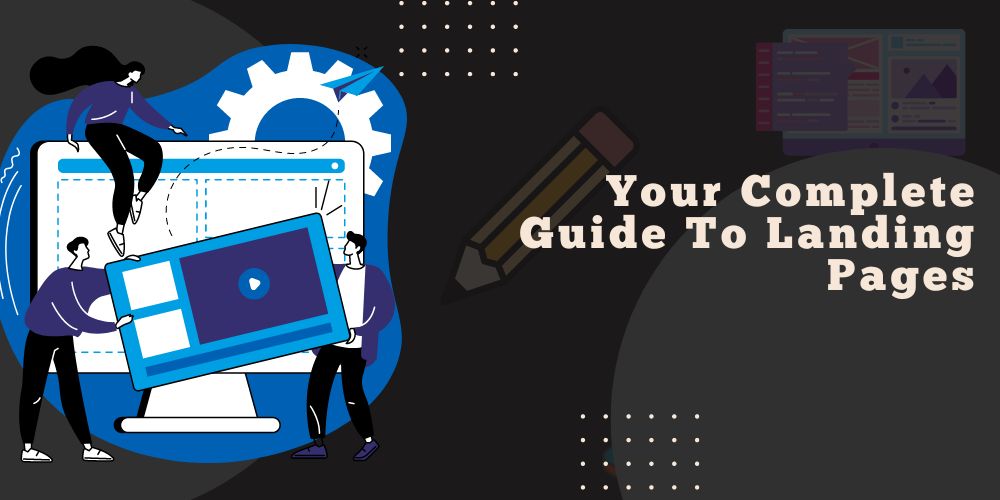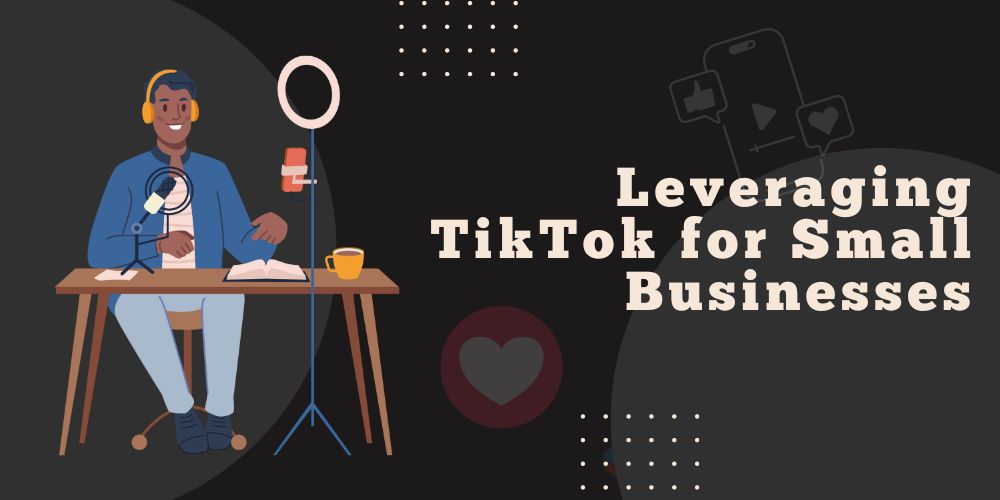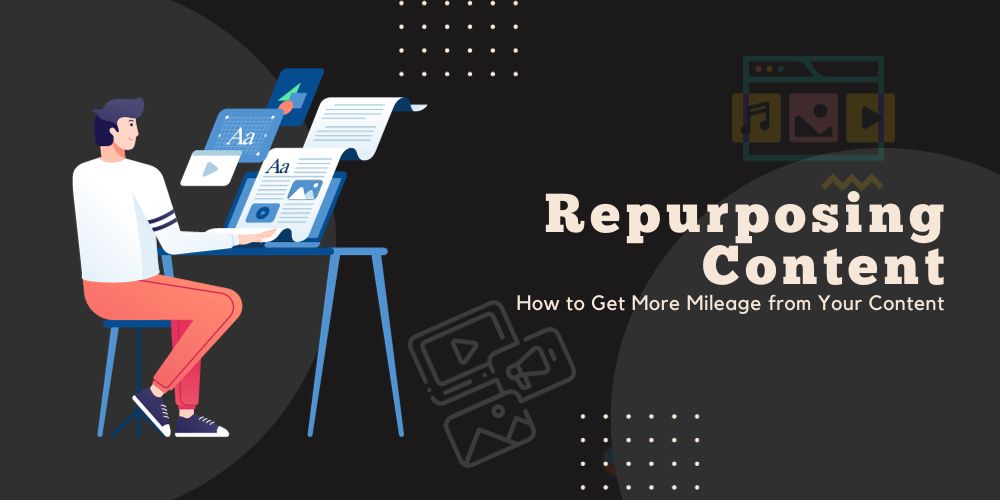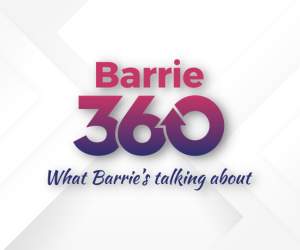Whether you’re a seasoned business owner who has experience with marketing or just dipping your toes into the world of digital marketing, understanding the ins and outs of landing pages is crucial for success.
In this comprehensive article, we’ll walk you through everything you need to know about creating effective landing pages that convert visitors into customers. So, let’s dive in and demystify the world of landing pages!
What is a Landing Page?
First things first, let’s talk about what a landing page actually is.
In simple terms, a landing page is a standalone web page created for a specific marketing or advertising campaign. Its primary purpose is to encourage visitors to take a specific action, such as signing up for a newsletter, downloading an ebook, making a purchase, or filling out a contact form.
You might wonder, “Why not just use my homepage?”
Well, here’s the thing … Landing pages are tailor-made for conversions. They eliminate distractions, focusing your visitors’ attention on the call to action (CTA) you want them to take. This makes them highly effective for converting visitors into leads or customers.

What is the Difference Between a Landing Page and Other Pages on Your Website?
If you’re still wondering how a landing page differs from other website pages, here’s a deeper dive into the key differences between the two:
1. Purpose
Website Page: Website pages, on the other hand, serve a broader purpose. They are part of your overall website and provide information about your company, products, services, and other content. Website pages can include your homepage, about page, contact page, product pages, blog posts, and more. They aim to provide a comprehensive view of your business.
Landing Page: Landing pages are designed with a single, specific goal in mind, such as encouraging visitors to take a particular action, like signing up for a newsletter, downloading an ebook, or making a purchase. They are often used in marketing campaigns to drive conversions.
2. Content
Website Page: Website pages contain a wide range of content, including text, images, videos, navigation menus, and links to various sections of the website. They provide comprehensive information about your business, products, services, and other relevant topics.
Landing Page: Landing pages are typically focused and concise. They have minimal distractions and contain content directly related to the specific call to action (CTA) you want visitors to take. They often include a headline, subheadline, compelling copy, an image or video, a lead capture form, and a clear CTA. We’ll talk about landing page content in more detail in just a bit.
3. Navigation
Website Page: Website pages typically include navigation menus that allow visitors to explore different sections of the website. They provide a more extensive browsing experience.
Landing Page: Landing pages often remove navigation menus and links that could divert visitors’ attention away from the primary CTA. The goal is to keep visitors focused on the specific action you want them to take.
4. Design
Website Page: Website pages have a more diverse design, accommodating various types of content and information. They may have a consistent branding style but can vary in layout and design based on their specific purpose.
Landing Page: Landing pages are designed for conversion optimization. They have a clean and focused layout, often with persuasive elements like compelling headlines, CTA buttons, and trust signals.
5. Traffic Source
Website Page: Website pages are part of your website’s overall structure and can be accessed directly by users who navigate to your site or find it through search engines.
Landing Page: Landing pages are often associated with specific marketing campaigns or traffic sources. Visitors typically arrive at a landing page through a targeted ad, email marketing, social media, or other promotional channels. Landing pages don’t necessarily need to be optimized for search engine traffic. (We’ll discuss this in more detail when we talk about the length of your landing page.)
Both types of pages play crucial roles in your online presence, with landing pages optimized for driving specific actions and website pages providing a comprehensive overview of your business.
What are the Benefits of a Landing Page?
Landing pages, when used strategically, offer a multitude of benefits that can significantly boost your business’s success. In this article, we will explore the advantages of landing pages and why they are a valuable asset for any marketing campaign.
Focused Conversion
Landing pages are designed with a single, clear call-to-action (CTA) in mind. Unlike a homepage or a general product page, a landing page is dedicated to a specific goal, such as signing up for a newsletter, downloading an e-book, or making a purchase.
This singular focus eliminates distractions and guides visitors toward the desired action, increasing the likelihood of conversion (which leads us to our next point).
Higher Conversion Rates
One of the most compelling benefits of landing pages is their ability to significantly boost conversion rates.
Since landing pages are tailored to a specific audience and goal, they are more persuasive and relevant. This targeted approach resonates with visitors, making them more likely to convert into leads or customers.
Improved User Experience
Landing pages are designed to provide a seamless and user-friendly experience. They are often stripped of navigation menus and unnecessary links, creating a distraction-free environment.
This streamlined design ensures that visitors can easily find the information they need and take the desired action without any confusion.
Improved PPC Campaign Results
Landing pages can be a cost-effective way to generate leads and conversions using PPC.
When designed and optimized correctly, landing pages can yield high returns on investment (ROI) by converting a larger amount of visitors into valuable leads or customers.
Enhanced Data Collection
Landing pages are a goldmine for data collection.
When visitors engage with your landing page, you can gather valuable information about their behavior, preferences, and interests. This data can then be used to refine your marketing strategies, personalize future interactions, and segment your audience for more targeted campaigns.
Better Targeting
Landing pages play a crucial role in enhancing targeting efforts by providing a focused and tailored experience for website visitors. By aligning the content, design, and messaging of a landing page with the intended audience and campaign objectives, businesses can effectively target their ideal customers.
In addition, If you have multiple audiences you would like to target, you can create a landing page that speaks to each group and then market it accordingly. This is a level of personalization that can be hard to achieve with a homepage.
Elements You Need to Create an Effective Landing Page
Now that you know what a landing page is, let’s break down its essential components:
1. Headline
Your headline is the first thing visitors see, so it needs to pack a punch. It should be clear, concise, and directly related to your offer.
A well-crafted headline should resonate with the visitor’s needs or desires, giving them a compelling reason to stay and explore further.
(We’ll talk about crafting headlines in more detail later on in this article.)
2. Subheadline
Think of the subheadline as the supporting actor to the headline’s star. It provides additional context or benefit, reinforcing the message conveyed in the headline.
While the headline grabs attention, the subheadline clarifies the offer and helps visitors understand why it’s valuable to them.
3. Compelling Copy
The body of your landing page is where you have the opportunity to dive into the details of your offer. Use simple and persuasive language to explain how your product or service can solve the visitor’s problem or fulfill their needs.
Focus on the benefits your offer provides, addressing the “What’s in it for me?” question that’s on every visitor’s mind.
Remember, visitors are more likely to convert when they understand the value they’ll receive.
4. Imagery
Visual content can be incredibly powerful. Incorporate relevant images or videos that resonate with your target audience. This can help to evoke emotions, provide a visual representation of your offer, and make your landing page more engaging.
Choose visuals that complement your message and help visitors better connect with your product or service.
5. Call to Action (CTA)
Your CTA button is where the magic happens. It’s the element that drives the desired action, whether it’s making a purchase, signing up, or downloading content.
Make your CTA button stand out prominently on the page. Use action-oriented text that leaves no room for ambiguity, such as “Get Started,” “Download Now,” or “Buy Today.”
The CTA should be compelling, crystal clear, and impossible for visitors to ignore.
6. Lead Capture Form
If your goal is lead generation, your lead capture form is crucial.
Keep it short and sweet to minimize friction. Asking for too much information upfront can deter potential leads. Typically, you’ll want to collect essential details like name and email address.
You can always gather more information later in the customer journey. Consider using smart forms that adapt based on the visitor’s previous interactions to keep the process user-friendly.
7. Trust Signals
Building trust is paramount in the online world, which is why you want to showcase trust signals on your landing page to instill confidence in your visitors. This can include trust badges, certifications, industry awards, customer testimonials, case studies, or endorsements from recognized authorities.
These elements reassure visitors that your offer is legitimate and can deliver on its promises.
8. Mobile Optimization
Many users browse and convert on smartphones, so a mobile-responsive design is non-negotiable.
Test your landing page on various mobile devices to ensure that it not only looks good but also functions seamlessly, with quick loading times.
9. Thank You Page
Once visitors have completed the desired action on your landing page, it’s essential to guide them seamlessly to a thank you page.
This often-overlooked step in the conversion process serves multiple purposes. Firstly, it acknowledges the visitor’s engagement, offering a personalized touch by expressing gratitude for their action. It also provides an opportunity to deliver further instructions or information, such as what to expect next or how to access their download.
Most importantly, the thank you page is an ideal platform to present additional offers or content that may be of interest to the visitor, maximizing the value of their interaction with your brand.
Remember, the success of your landing page hinges on the careful combination and optimization of these elements. Each one plays a vital role in guiding your visitors toward taking the desired action, whether it’s making a purchase, signing up, or engaging with your brand.

Design and Layout Tips for Landing Pages
Creating an effective landing page is not just about what you say but also how you present it. The design and layout of your landing page play a pivotal role in capturing and maintaining your visitors’ attention. Here are some essential tips to consider:
1. Clean And Simple Design
Simplicity is your ally when it comes to landing page design. A clutter-free layout ensures that visitors can focus on your core message and call to action (CTA) without distractions. Remove any unnecessary elements that do not directly contribute to your conversion goal. Keep the design visually appealing but uncluttered.
2. Color Psychology
The strategic use of colors can evoke specific emotions and influence user behavior. Consider the psychology of color in your design. For example, blue often conveys trust and professionalism, while red can create a sense of urgency.
Align your color choices with your brand’s identity and the emotional response you want to elicit from your audience.
3. Consistent Branding
Maintaining a consistent look and feel with your website’s branding is vital. Your landing page should align with your overall brand identity to reassure visitors that they are in the right place. Consistency in fonts, colors, logos, and imagery helps establish trust and credibility.
RELATED: The importance of brand consistency in marketing …
4. Visual Hierarchy
Guide your visitors’ eyes with a clear visual hierarchy.
Place the most critical elements, such as your headline and CTA button, prominently on the page.
Use size, color, and positioning to draw attention to these key components. Subordinate elements, like supporting images and additional content, should be visually secondary.
5. Whitespace
Whitespace, or negative space, is your friend. It’s the area of a web page or design composition that’s intentionally left blank or unmarked — it doesn’t necessarily have to be white but is usually devoid of content or graphics. Whitespace can be found between text, images, headings, margins, and any other elements on a webpage.
Whitespace provides breathing room for your content and makes your landing page more readable and visually appealing.
Don’t be afraid to use ample whitespace around your headline, subheadline, and CTA button to make them stand out.
6. Load Times
Page speed matters. Slow-loading landing pages can lead to high bounce rates, which is the percentage of visitors who navigate away from a website after viewing only one page, typically within a short period of time, without interacting with other pages or content on the site.
To increase page speed, optimize your images and minimize unnecessary scripts to ensure fast load times. Users expect pages to load quickly, and a delay can discourage them from taking action.
Incorporating these design and layout principles into your landing page can help create a visually appealing and highly effective conversion tool.
When you are unsure of what to do remember this … The ultimate goal is to make it easy for visitors to understand your message, engage with your content, and take the desired action.
Crafting Irresistible Headlines and Content
Your landing page’s headline and content are your persuasive tools. To create compelling content, follow these tips:
Headlines
- Start with a clear purpose and goal for your headline.
- Understand your audience’s interests and pain points, then speak directly to them.
- Use power words, numbers, and questions to make headlines attention-grabbing.
- Create a sense of urgency or exclusivity to encourage immediate action.
- Promise value or a solution to the reader’s problem.
- Keep headlines clear, concise, and relevant to the content.
- Use simple language and avoid jargon.
Content
- Begin with a strong, engaging opening that addresses the reader’s needs or questions.
- Tailor your content to your target audience’s preferences and interests.
- Speak directly to your audience’s needs and desires.
- Use persuasive language to highlight benefits and solve problems.
- Use simple language and avoid jargon.
- Keep the tone conversational and relatable.
- Keep your message focused and to the point.
- Break up content with subheadings, bullet points, and visuals for readability.
- Address objections or doubts your audience might have.
- Include social proof like testimonials or case studies for credibility.
- End with a clear and compelling call to action (CTA).
- Edit and proofread meticulously to eliminate errors.
How Long Should A Landing Page Be?
Your landing page should only include content and copy that is absolutely necessary to drive your reader to the desired action. Unnecessarily cramming extra content will only distract your user, which can reduce conversions.
As a result, there is no hard and fast rule for word count and content length.
The one exception would be if you are hoping to drive traffic organically using search engine optimization. While this is not the usual purpose of a landing page, it is one strategy that can be used to drive traffic. In these situations, you want your landing page to have at least 300 words, though we recommend a minimum of 500.
Analyzing and Optimizing
After your landing page goes live, the work doesn’t stop. Regularly analyze the page’s performance using tools like Google Analytics or your chosen marketing platform.
Pay attention to metrics like conversion rate, bounce rate, and time on the page. Use these insights to make informed optimizations, tweaking elements that aren’t working as well as you’d like.
The Power of A/B Testing
Creating the perfect landing page often involves experimentation.
A/B testing (or split testing) is a valuable technique that’s used to optimize your page’s performance. It involves creating two versions of your landing page with one element (e.g., the headline, CTA button color, or form length) being different between them.
You can then compare the conversion rates of each landing page to determine which version is more effective.
By systematically testing different elements, you can continually improve your landing page’s performance.
8 Strategies to Drive Traffic to Your Landing Pages
Creating a compelling landing page is just the first step in a successful digital marketing campaign. To achieve your conversion goals, you need to drive targeted traffic to your landing pages. After all, what good is a beautifully designed page if no one sees it?
To help you out, here are some effective strategies you can use to boost traffic to your landing pages and maximize your chances of converting visitors into customers.
1. Pay-Per-Click (PPC) Advertising
PPC advertising platforms like Google Ads and Bing Ads allow you to target specific keywords and demographics to reach a highly relevant audience.
Create compelling ad copy with attention-grabbing headlines and concise descriptions that entice users to click through to your landing page.
2. Social Media Marketing
Social media platforms offer a goldmine of opportunities to promote your landing page. Regularly share your content on platforms like Facebook, Twitter, Instagram, and LinkedIn.
Engage with your audience, run targeted ads, and join relevant groups or communities to establish your authority and drive traffic from these channels to your landing page.
3. Content Marketing
Content is king, and creating high-quality, optimized content that is relevant to your audience can drive traffic to your landing pages.
Write blog posts, create informative videos, or develop infographics that link back to your landing page. Share this content through various channels, including your website, social media, and email newsletters.
4. Email Marketing
Your existing email subscribers are already interested in your offerings, making them prime candidates to visit your landing page.
Craft enticing email campaigns that highlight the benefits of your product or service and include a clear call to action (CTA) leading recipients to your landing page. Segment your email list to ensure that each group receives tailored content and offers.
5. Influencer Marketing
Collaboration can be a powerful tool in driving traffic.
Partnering with influencers in your niche can expose your landing pages to a broader audience. Collaborate with influencers who align with your brand and have a significant following. They can promote your landing page to their followers, generating more traffic and potential conversions.
6. Guest Blogging
Contribute guest posts to industry-related blogs and websites. In your author bio or within the content, include a link to your landing page.
Guest blogging not only drives traffic but also helps establish you as an authority in your field.
7. Online Communities and Forums
Participate in relevant online communities and forums like Reddit, Quora, or niche-specific forums. Answer questions, provide value, and discreetly share links to your landing pages when they are contextually relevant.
But remember to always follow community guidelines and avoid spammy behavior.
8. Referral Traffic
Encourage existing customers and partners to refer others to your landing pages.
Implement referral programs or offer incentives for successful referrals. Word-of-mouth and recommendations can be powerful drivers of traffic.
These are just some of the ways to drive traffic to your landing pages. There are endless possibilities from interactive quizzes to QR codes in print to radio ads, the opportunities are endless.

The Power of Landing Pages
Landing pages are an indispensable part of your digital marketing toolkit. They provide a focused platform to connect with your audience and achieve your business objectives.
By following the principles and tips outlined in this guide, you’ll be well on your way to creating landing pages that convert like a pro.
Remember, landing page success often comes through a process of trial and error. Don’t be afraid to experiment, analyze, and refine. With dedication and the right approach, your landing pages can become powerful conversion machines.






